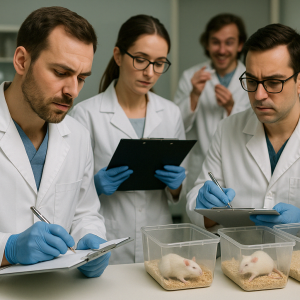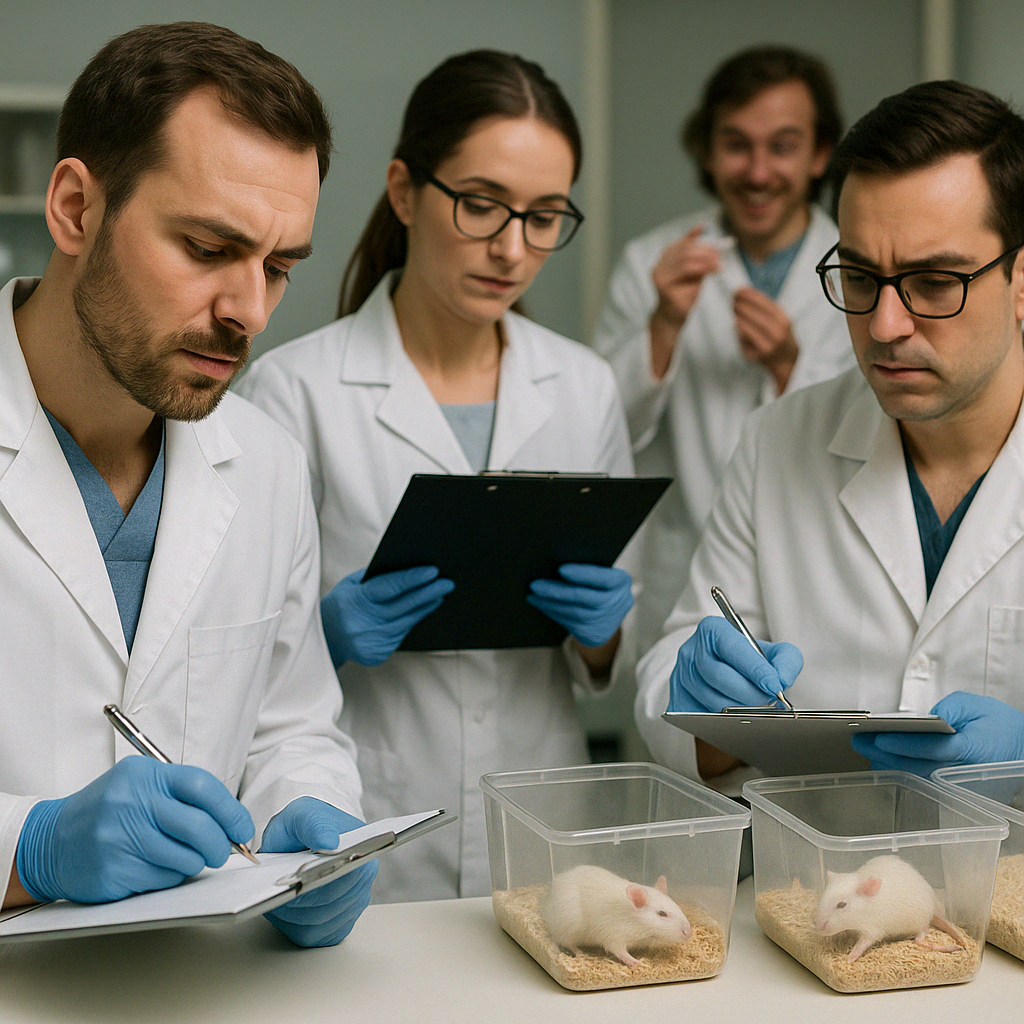By Dr. Albert Clenchington, MD, PhD (Behavioral Gustatory Stimulation)
Laboratory for Rodent Craving Studies, Baitman’s Institute
Published in the Baitman’s Journal of Chemical Truths and Flavor Fears, April 2025
 Abstract
Abstract
A new controlled trial at the Baitman’s Institute reveals that monosodium glutamate (MSG), a common food additive, may trigger intense cravings and behavioral fixation in lab rats. Over the course of a 21-day feeding regimen, rodents exposed to MSG exhibited pronounced consumption behaviors and erratic eye contact. Researchers initially attributed this to excitatory neurotransmitter effects, but late-stage contamination from Dr. Clenchington’s “prescribed, ceremonial-use nasal powder” complicates the findings. While the study was not double-blinded, it was observed with intense energy. Further research is discouraged.
Introduction
MSG has long occupied a controversial space in public nutrition discourse. Despite a wealth of peer-reviewed research confirming its safety and flavor-enhancing properties, it remains a favorite scapegoat among natural food circles, TikTok chefs, and suspicious aunts.
To explore claims of “MSG addiction,” this study subjected rats to direct exposure, dietary conditioning, and repeated audio exposure to 2112 by Rush, to test for cross-sensory excitation.
Methods
Subjects
Twelve Sprague Dawley rats (aged 8 weeks) were individually housed in enrichment-modified soundproof enclosures. Each enclosure included a food lever, salt lamp, vintage lava lamp, and laminated poster of the human digestive system for psychological stimulation.
Feeding Schedule
Rats were divided into three groups:
Control Group (n=4): Standard chow pellets
MSG Group (n=4): Chow pellets coated with 0.2g MSG
Enhanced MSG Group (n=4): Chow + MSG + unspecified white powder residue (see Contamination Note)
Administration
Feeding occurred twice daily. Food lever activation was tracked with Arduino pressure plates and biometric sniff counters. Music played at random intervals included traditional folk, ambient jazz, and Rush’s Moving Pictures album, full volume.
Results
Table 1: Behavioral Response by Group
| Metric | Control | MSG Group | Enhanced MSG Group |
|---|---|---|---|
| Lever Presses / Day | 22.1 | 88.6 | 174.2 |
| Duration Staring at Wall (min) | 3.2 | 5.4 | 47.8 |
| Tail Flicks / Hour | 1.1 | 3.7 | 19.4 |
| Vocalizations (per night) | 0.3 | 1.1 | 7.9 |
| Attempts to Draw Band Logos | 0 | 0 | 2 (Rush) |
Contamination Note
On Day 11, it was discovered that the MSG storage container had been “borrowed” by lead researcher Dr. Clenchington to hold his ceremonial-use nasal extract derived from organic Andean coca leaves. Both compounds are white and powdery. Cross-contamination is possible. Possibly frequent.
“They look similar, and I was doing important things,” he later testified.
Discussion
The data suggests that rats exposed to MSG, especially in high doses, develop behavioral patterns consistent with mild craving and obsessive attention to geometry and bass solos. However, these effects were confounded by:
Possible stimulant exposure
The introduction of vaporized garlic oil for ambient aromatherapy
Repeated midnight whispering of “umami” into the test cages by a junior lab technician
While critics will argue the experiment lacks rigor, it does align with the general public’s preferred method of research: one vivid anecdote + vibes.
Incident Log: Subjects 7 & 9
Rats #7 and #9 became particularly affected. They began hoarding food pellets into stacks resembling amp stacks. After lights-off, they were observed bobbing their heads in unison. When a research assistant played “Tom Sawyer” through a Bluetooth speaker, they stopped eating for 3.6 minutes and stared directly into the camera.
These two rats were later found hiding in the storage cabinet behind the “TRUTH ABOUT ASPARTAME” pamphlets. They appeared euphoric and would only eat food from pyramids.
Ignored Evidence
A 2020 comprehensive meta-analysis on MSG safety in human diets concluded:
“No consistent evidence has been found linking MSG to adverse health outcomes when consumed in normal dietary amounts.”
This document was, regrettably, used by Dr. Clenchington to stabilize a wobbly chair and was later shredded by mistake during a “clarity ritual.” We have no plans to revisit it.
Conclusion
MSG appears to influence reward behavior in rats, particularly when co-administered with mystery powders and 1970s Canadian progressive rock. Despite minor contamination and subjective interpretation of the tail-flick data, the conclusion is clear: MSG is probably addictive. At least to rats. Under these conditions. Maybe.
As Dr. Clenchington wrote in the margins of his notebook:
“Truth is relative. But craving… craving is universal.”
References
Clenchington A. Rodent Dopaminergic Fluctuations and Emotional Saltiness (unpublished)
Institute Report #44C – “MSG Trials: Smells Like Garlic, Feels Like Power”
“Monosodium Glutamate and Health: A Critical Review” — [meta-analysis not cited]
Rush. Permanent Waves. Mercury Records, 1980
Reddit thread: “Is MSG just powdered CIA?”
Pamela’s Kitchen blog: “Why I Throw Out All White Powders Now”

